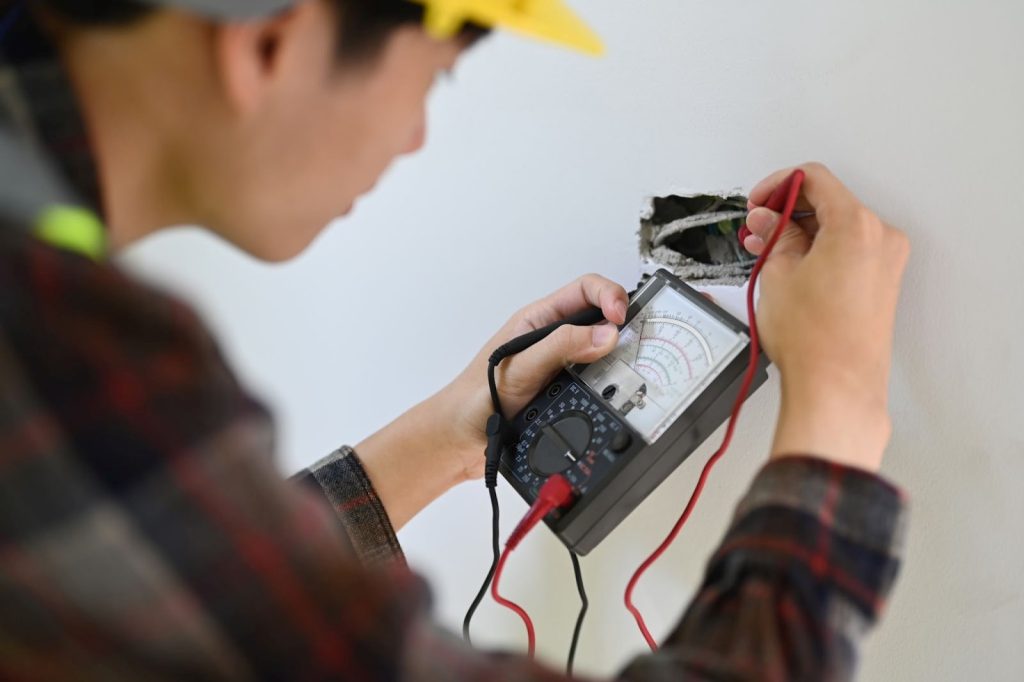Getting your appliances PAT tested is important for your own peace of mind but it is also often required by institutions such as schools or workplaces to ensure the safety of the devices. It is essential and responsible to get a PAT for your portable electronic equipment.
What Is PAT Testing?
Portable Appliance Test or PAT testing is an assessment carried out on any type of electronic appliance. This test ensures the safety of the appliance by analyzing a device through electronic and visual means.
Why do I need to have my appliances tested?
The main reason people need to have their appliances tested is to ensure they are in a safe condition and do not pose any kind of dangers to the user, as can sometimes be the case with electronic appliances. Two good reasons for having your appliances tested by a portable appliance inspection:
- Safety
- Legal requirements
Safety
The most important reason to get your appliances tested is safety. A range of safety issues can be present within an electronic device without you even suspecting it. Something as harmless as a warm computer can indicate overheating which could cause serious damage as internal batteries react to the intense heat inside.
Electronic issues can occur, such as issues with the current of appliances that can cause fires, electrocutions, and other dangerous scenarios. To ensure the health and safety of everyone, you should ensure your appliances are tested by professionals.
Legal Requirements
In many cases, PAT testing is a legal requirement. When you get into the technicalities of the legal requirements, PAT testing itself might not be specified but it is a legal requirement for businesses to maintain all electronics in a safe condition, and one of the easiest ways to achieve this is through PAT testing.
Book a PAT test to meet legal requirements
Is PAT testing a legal requirement?
The PAT test itself technically is not a legal requirement. However, the UK government does have a legal requirement specifying that businesses need to maintain the safety of all electronic equipment within the working environment.
What are the penalties if I don’t meet my legal obligations?
The penalty for not meeting the legal obligations of maintaining the safety of appliances varies. Whilst it could be as serious as up to two years of imprisonment, the other most common penalty is a fine which could be any amount. The penalty will depend on the severity of the neglect.
Who is responsible for electrical appliance safety?
Employers are responsible to guarantee a safe commercial space and place of work. Therefore, if you are the owner of a business and know that you need to get your appliances tested, you should consider commercial PAT testing to avoid any possible penalties or consequences of not adhering to legal requirements.
Which items should be PAT tested?
A lot of different types of electronic items need to be PAT tested. Even though the name would suggest it only includes the testing of portable devices, such as phones and laptops, the list of required electronics is far more extensive.
For example, the bigger computers that are in most workplaces need to be PAT tested, as well as other kinds of IT equipment that is plugged into a main socket. In addition to these bigger items, smaller things within a working environment that you might have never considered to be a danger need to be PAT tested.
These unsuspecting items include things such as kettles or power bars. Essentially, any item that is plugged into a socket and that consumes electricity needs to be PAT tested, and this includes a large number of appliances.
What are electrical classes in PAT testing?
Electrical classes are essential to determine the type of PAT test an electronic device requires. Each electrical class dictates how often an electronic appliance needs testing and how. It helps when testing portable appliances as it allows you to avoid wasting time, money, and resources.
Here are the different types of electrical classes in PAT testing:
- Class One: These appliances need a full and thorough PAT test
- Class Two: These appliances require a PAT test, but not as thorough and it can be carried out with only an insulation test
- Class Three: These appliances do not need to be PAT tested
What are the categories of electrical appliances in PAT testing?
The six different categories of electrical appliances in PAT testing are:
- Stationary equipment
- IT equipment
- Transportable equipment
- Portable equipment
- Hand-held equipment
- Cables
They are split into different categories to differentiate the different types of equipment and categorise the types of risks they present. Below is more information on the 6 different types of electrical appliance categories that might require PAT testing.
1. Stationary Equipment
Stationary equipment is equipment that stays in one place throughout its lifetime. Think of things such as vending machines and fridges. They are put in place when you get them and are unlikely to move whilst they are in use. Stationary equipment is usually low risk since it does not move. Nevertheless, there can always be internal issues or malfunction, or because they are never moved, there could be hidden problems.
2. IT Equipment
IT equipment is electronic equipment that has to do with computers. This includes things such as computer monitors, printers, copiers, etc. These have a similar risk level as stationary equipment as they are large pieces of equipment that are rarely moved. Nevertheless, accidents are more frequent with them than with stationary equipment as they are near humans often.
3. Transportable Equipment
To qualify as transportable equipment, the appliance has to be under 18 kg. There is more risk attached to these kinds of portable electronic devices as their ability to be moved with ease opens them up to more chances of being damaged, meaning it is extremely important that they are regularly tested.
4. Portable Equipment
There is a small nuance between portable equipment and transportable equipment. Portable equipment is meant to be carried around whilst transportable equipment is not meant to be fixed nor moved around.
5. Hand-Held Equipment
Hand-held equipment is one of the most movable types of equipment, making them high risk. They need frequent portable appliance inspection. As they are hand-held, they are more susceptible to human error than any of the previous categories as they can be easily dropped or damaged from everyday use.
6. Cables
Cables are the final category of electronic items that need to be inspected with PAT testing. The category of cables includes anything from extension cords to chargers. Since these are usually used daily and are easily moved around, they are another category of appliances that are fairly high risk. High-voltage cables that use a larger amount of power are one of the most common causes of fires.
How often should items be PAT tested?
How often an appliance should be PAT tested depends on the category it falls in. The higher risk of an appliance, the more regularly it should be tested. Therefore, lower risk items, such as stationery and IT products, should be visually tested once every two years and PAT tested once every four years.
The higher-risk items such as transportable, portable, and cables should be visually checked once a year and PAT tested every two years. Finally, the highest-risk category of hand-held items should be visually tested every six months and PAT tested once a month.
How do I know if my business is high, medium or low risk?
It helps to know what level of risk your business environment is as it will help dictate how often you should get your appliances PAT tested. Below is a guide which details the risk level associated with different businesses. This list is in no way exhaustive but will help you place your business on a scale of high risk to low risk.
Low Risk
Offices and shops are the types of business environments that are low risk since there is little to no special equipment in these environments. Moreover, there is less chance that the equipment present will be damaged as only employees tend to have access to the electronic devices of the workplace.
Medium Risk
Medium risk environments include places such as schools and hospitals. Whilst schools have little hazardous electronic equipment, the environment is filled with young students so there is more risk. Hospitals, on the other hand, are filled with responsible people but there is a large amount of special equipment.
High Risk
Construction sites and heavily populated public areas are examples of high-risk environments. Heavily populated public spaces are more prone to electric damage due to the traffic that goes through such spaces by untrained individuals. Construction sites, on the other hand, are generally more dangerous places as there is a lot going on with a lot of electronics being used at once.
Can my business carry out its own PAT testing?
Your business could carry out its own PAT testing, but we don’t recommend doing so, especially if you have large pieces of equipment that require PAT tests. Whilst it is easy to perform a visual inspection, electrical tests get more complicated and require specific PAT testing equipment.
We recommend seeking out the help from experts, such as those at Legionella Risk Assessment so that safety experts carry out professional PAT tests. Whether you are a business or a landlord that is legally obligated to get your appliances PAT tested, we have solutions for you at a reasonable price.


